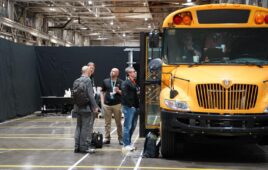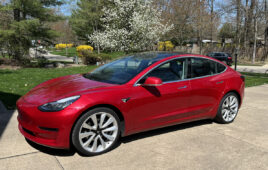 By Jody Muelaner
By Jody Muelaner
A vehicle’s architecture describes its key elements, especially how they are laid out and connected to each other. Traditionally, the focus has been on the mechanical architecture; the chassis and frame, powertrain, body, fuel system, and interior layout. Early electric vehicles (EVs) changed internal combustion engine (ICE) vehicle architecture as little as possible by trying to fit the electric powertrain into the space left by the ICE powertrain.
Current EVs have mechanical architectures designed from the ground up for electric powertrains which require a larger volume but that can be shaped more flexibly. Entirely different architectures are required for different types of EVs: Battery electric vehicles (BEV); hybrid electric vehicles (HEV); plug-in hybrid electric vehicles (PHEV); and fuel cell electric vehicles (FCEV).
Architecture not only affects the performance and functionality of a vehicle, but also has a major impact on how it is manufactured, with architectures optimized for mass production. Electronic and software systems are now becoming increasingly important in defining a vehicle’s architecture, with the concept of a software defined vehicle becoming prevalent.
Moving from ICE to EV mechanical architectures
The well-established ICE architecture with most of the powertrain located under the hood at the front of a vehicle is driven by the relatively fixed and boxy shape of the engine, the need for a large radiator to cool the engine, and access requirements for regular maintenance. When fuel is burned in an engine, less than 40% of the energy is converted to work, with the rest needing to be dissipated as waste heat. The radiator is therefore a central consideration in ICE architecture. BEVs have efficiencies of around 90%, meaning about 1/6th of the cooling requirement, so the radiator can be much smaller and doesn’t need to be in such a direct airflow. Additionally, BEV powertrain components require very little if any maintenance, meaning access is much less of a consideration.
The largest single component in an ICE powertrain is the engine, followed by the gearbox. These components have boxy shapes, determined by their mechanical function — and so a large dedicated space is required to house them. Most of the volume in a BEV powertrain is taken up by the battery pack, which can be made into virtually any shape to fit around other components, or even broken up into a number of smaller battery packs distributed around the vehicle. Other key powertrain components such as the inverter and motor are much smaller. The motor can often be mounted on the axle or even within the wheels.
While the chassis and frame of a BEV is not as radically different as the powertrain of an ICE vehicle, it will be changed due to the different shape and location of the powertrain. Many manufacturers including Tesla, GM, and VW are using a skateboard platform. These have a planar chassis housing the heavy batteries as close to the ground as possible and providing a flat base on which different vehicle bodies can be easily mounted. The motors is usually located on the axles between the wheels and suspension components also included.
Increasingly, manufacturers are looking to use structural batteries, where the batteries themselves act as the structural elements of the chassis or body, allowing significant reduction in vehicle mass. Such designs often take the form of a sandwich panel design, with outer sheets of aluminum or carbon fiber carrying the major in-plane and bending loads, while the battery cores resist transverse shear and compressive loads. This sandwich panel approach to structural battery integration is very well-suited to a skateboard platform.
Interior layouts have changed very little in BEVs. Despite the hood no longer being required to house an engine, manufacturers have continued to produce passenger cars that look very similar to ICE vehicles. This is perhaps as much about styling and familiarity as it is about the practical considerations of vehicle architecture. There is significant scope to produce more compact vehicles with more spacious interiors my moving to cab-over designs, with the driver and front passengers sitting over the front axle. This has the most potential for light commercial vehicles where such designs are likely to prevail as electrification increases in these vehicle segments.
Potential future EV vehicle architectures
Today’s EV designs are just scratching the surface of what is possible when vehicles are electrified. Current passenger cars are styled in a familiar way, with unnecessarily long hoods taking up space that could be used within the interior or simply to produce a more compact vehicle.
Current EVs inevitably use axle mounted motors, which still require a differential and axle. An alternative powertrain architecture would be to place four individual motors within the wheels. This would provide opportunities to save space within the vehicle, reduce mechanical drivetrain losses, and facilitate thrust vectoring for improved handling. It could allow a simple transition to skid steering for extreme low-speed maneuverability, great for parking and off-road driving.
When it comes to SUVs and true off-road vehicles, in-wheel motors could allow much greater ride height adjustment and ground clearance. However, there are good reasons while all mass produced EVs use axle mounted motors. Issues with in-wheel motors include greater weight and unsprung mass leading to less responsive suspension, higher cost from producing four rather than one or two motors, durability issues with exposure to road vibration, and issues packaging brakes within the wheel. Current EVs use high-speed motors combined with a reduction gearbox, giving the required torque in a much lighter package. In-wheel motors would need to be either much heavier direct drive motors, or have individual reduction gears packaged into each wheel. These gearboxes would also be subjected to road vibration. Despite some interesting possibilities, in-wheel motors do not look like something that will happen any time soon.
Vehicle-to-home (V2H) and vehicle-to-grid (V2G) capability allows a BEV to act as a home battery or grid attached storage when it is plugged in. Most cars are only driven for about an hour a day, so making use of all this battery capacity to store variable renewable energy makes sense. As battery durability and management improves, concerns over using up the life of these very valuable component of the vehicle are diminishing. Plug-in hybrid vehicles could provide even more potential for V2G, essentially acting as emergency generators attached to the grid for those rare but inevitable events when it is dark and windless for longer than batteries can provide energy. As we become increasingly dependent on renewable energy combined with short-term battery storage, some form of peaking power will be required in the grid to supply energy for when, during the winter when heating demand is high and days are short and dark, the wind sometimes stops blowing for a week or two. Building and maintaining power stations that only operate for a couple of weeks a years is very expensive in terms of CapEx — and these basic economics remain whether they are gas, coal or hydrogen. Utilizing the generation capabilities of PHEVs could therefore be the answer.
Electronic and software architectures
Modern vehicles, whether ICE or EV, are increasingly being defined by their electronic and software systems. There is a move towards zonal architecture in which systems are grouped according to their function and controlled more centrally by domain control units which then communicate beyond the zone. This can reduce complexity, improve fault detection and enable easier software updates. Server-based architecture centralizes functions even further into a few powerful vehicle computers known as servers. Domain control architecture is another similar approach.
Many vehicles now use an ethernet backbone as the main communication protocol between the different systems and sub systems of a vehicle. This enables high-bandwidth communication while leveraging the economies of scale in this standard technology.
“During the next few years, the automobile with develop into an IoT device on wheels. The basis for this is a paradigm shift in e-architecture that enables service orientation and a wholistic application software abstraction from the hardware. This involves the transition from the previous domain centric architecture, to a cross-domain architecture… controlled by high-performance vehicle computers. Mass production of such systems is set to begin by the second half of this decade… Special zone ECUs will be used to connect vehicle computers to the remaining embedded control units as well as to the sensors and actuators. The main benefits with this approach are cost and complexity reduction, improved economies of scale, more synergies and higher efficiency,” said Damian Dyrbusch, Head of Bosch Center of Competence for Mobility System Architectures.
Electrification has already had a massive impact on vehicle architecture, and we’re just at the start of this journey. Future vehicles with be software defined, autonomous and connected. They will be connected not only in terms of sharing data, but they will also form an integrated part of our energy system, providing energy storage and even power generation services to the grid while parked.
Filed Under: EV Engineering




